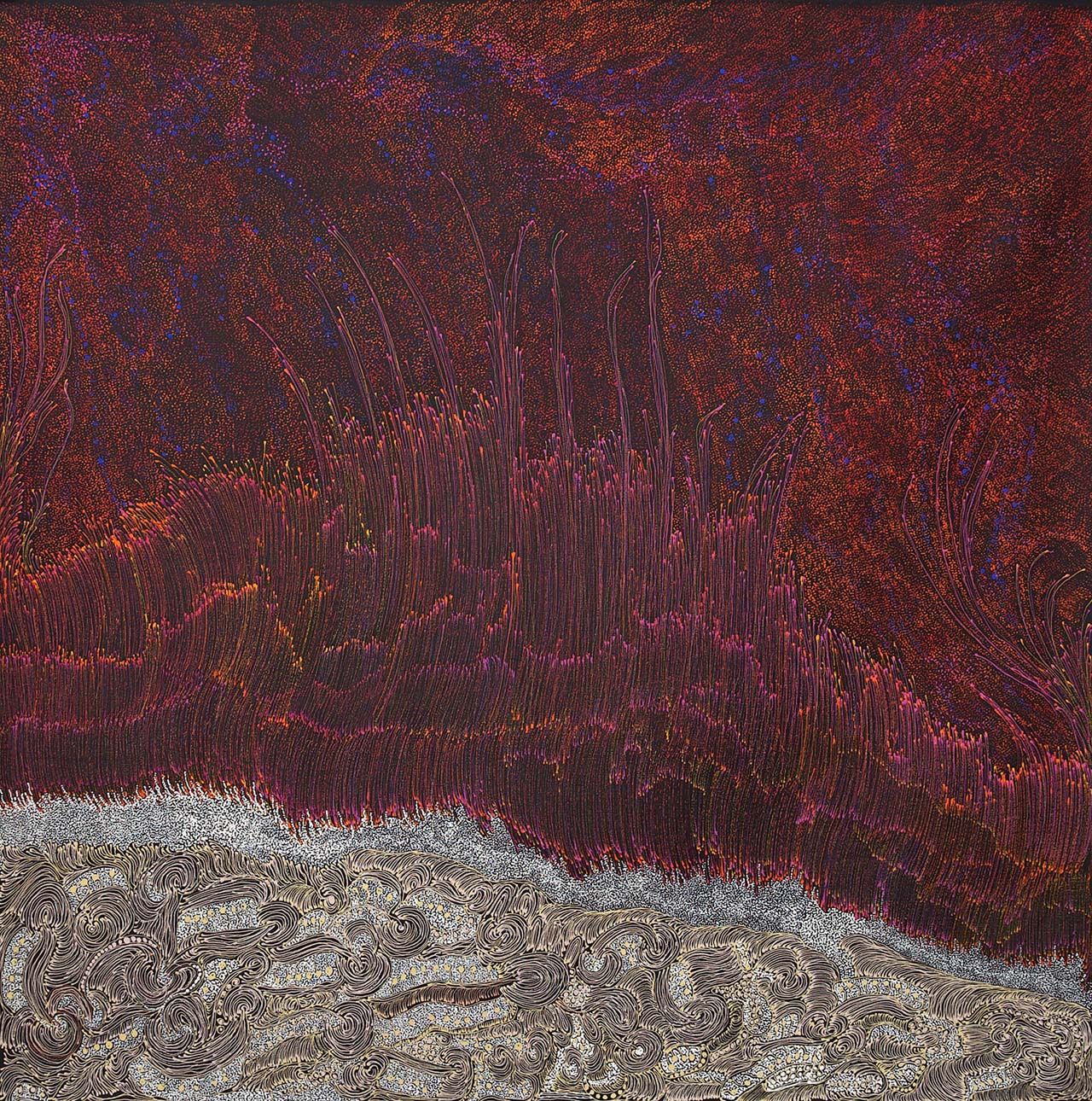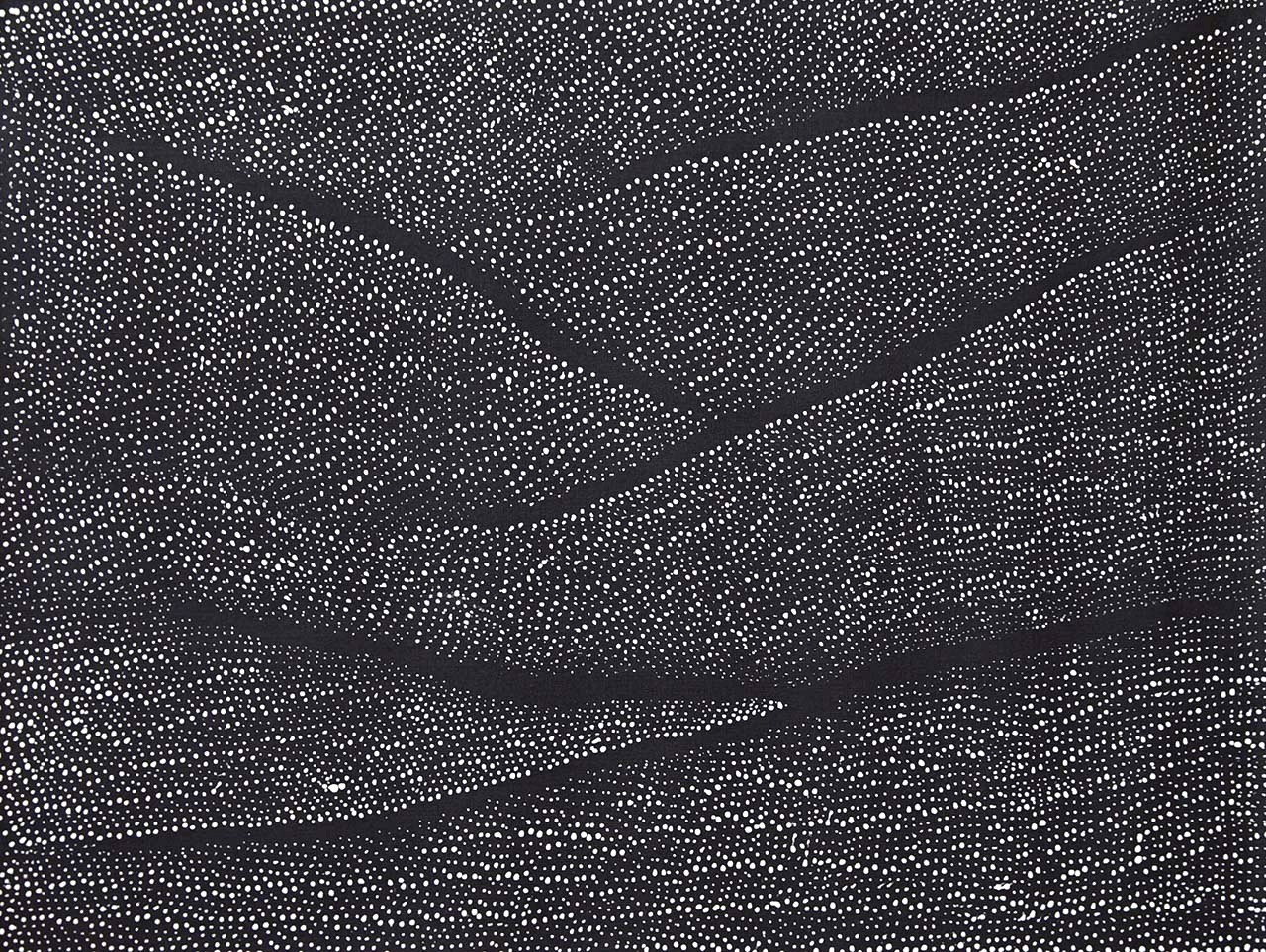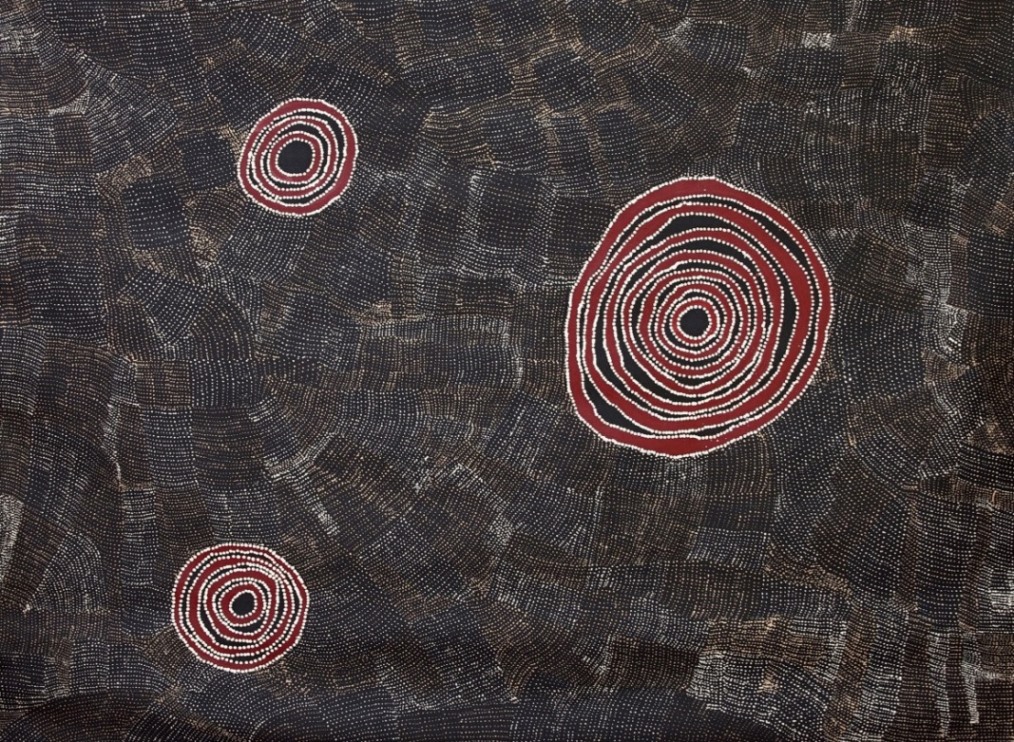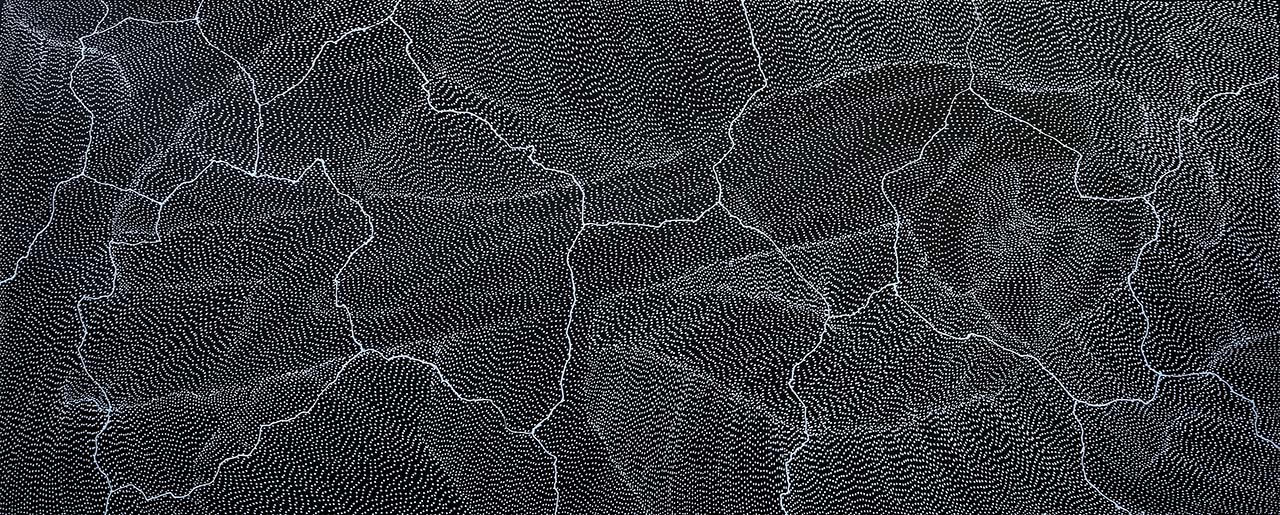Remarkable Contemporary Aboriginal Fine Dot Painting
In this article Japingka's Ian Plunkett discusses the work of five contemporary fine dot artists.
When it comes to fine dot painting, I definitely have my own favourites. These are people who I admire and whose technique is taking this exciting style of art in a slightly different direction.
Jorna Newberry

Jorna is the most radical of all these artists and she is probably one of the finest dot painters around. She's from the Warakurna way in the Western Desert. Her uncle is the famous Tommy Watson. He'd be nearly ninety or so now. His works sell for hundreds of thousands of dollars. She's worked with Tommy and been taught by him. Some of her early paintings reflect his influence in the way they are constructed. Her dots were always finer than Tommy's but that's possibly an age thing. Since her early work she's branched out. Initially her paintings had a little bit of Tommy in them and that's no longer the case.
Jorna’s paintings are all incredibly finely executed. I’m so impressed by the patience, the skill, the eyesight to be able to produce this work. In a painting which is probably a metre square you can see how dense and detailed it is. Each one of those is a free-hand dot that gives a three-dimensional effect. At the end of the day, it is a collection of dots but the skill in composing that is really something. You know, one mistake would virtually ruin the whole painting because your eye would be drawn to it yet the errors are not there. She just continually produces art to such a high standard and the best part is it doesn't look like any other painting you've seen. It's not derivative, it's unique, and it's inspirational.
I love her fire dreaming stories. You can almost see the flames licking up into the sky and the way the wind goes through and moves the fire with it. We call them fire dreamings. She also paints consistently about her mother's country. Her mother was responsible for the custodianship of the stories associated with the desert winds that blew through there, and of course fire and wind often go together.
Jorna’s got at least three different styles at the moment, all of them different. In fact if you looked at them you may not even think that they were the same artist. That's her skill, her diversity, and her eclectic influences. She sees the world in a way that only a real great artist can see it. She transforms a blank canvas into such a staggering thing of beauty and also awe. Seeing work like this is when you really come to appreciate indigenous art. Some people describe aboriginal art, "Oh, it's just dots." Well, firstly that's not true but secondly, even if it was, "Yeah, but look at those dots," is what I'd say. Look what you can do with it. It's so much more than that. I think Jorna is an artist to watch.
Sarrita King

Sarrita King is an amazing woman and I have a lot of admiration for her. At twenty-seven she had exhibited in Paris and Berlin and Singapore. She's unique, her work has that same attention to detail. She paints really fine work dots that actually create a pattern. Her ancestor dreaming paintings are stunning.
The aerial views of her country and the main spiritual centres of those countries are depicted in dots but it looks like you're just looking out of an aeroplane window as you're flying over one of the desert areas. It's such a effortless depiction of her country.
In some way she's does all the elements, too, because she does the lightning dreaming, the fire dreaming and the water dreamings as well. All the elements are represented in her paintings. Sarrita is going to go a long way.
Maureen Hudson Nampijinpa

Maureen Hudson Nampijinpa is a real star and she's been painting for a long time. She's a Walpiri artist. Some of her paintings are of the waterhole dreaming, which are aerial views of maps of all the waterholes in her country and how they're all interconnected among all the sandhills. What's interesting is that she knows where all the waterholes are and she depicts them in an aerial view or a map. However if you're flying over the country you wouldn't see those waterholes because they're all underground. You'd actually have to dig down to get to that water. It's not on the surface but it's a tradition the way the indigenous people depict waterholes is these circles or concentric circles in the landscape. In reality you wouldn't be able to see them.
For desert-dwelling people water is a matter of life and death. Waterholes have much mythology built around them and much importance. The people who are the custodians of the dreamings associated with waterholes are very important people in the community and the society as a whole. This is because their knowledge and their custodianship of one of the main resources.
Maureen Hudson is unique in that she has larger dots than any of the other people we're talking about. She is using an almost double dotting technique. You can see a faded dot inside each one of her dots and every second or third dot is what's called a disappearing dot in that it's in a different palette so it tricks the eye a little bit when you're looking at it. It's there sometimes and other times it's not, but she paints these enormous landscapes of sandhills and, again, just using this disappearing dot technique of interspersing different colours in the dots she creates these three-dimensional landscapes. If you look at her paintings you can see the valleys between the sandhills that she paints. You can see the rise and fall of the sandhills and it's really quite hypnotic. She's one of the few artists that I know who creates these optical illusions. A few of the more famous Pintupi artists are also renowned for creating optical effects but they tend to do it in a different way, usually with lines, not always dots.
Lily Kelly Napangardi

Lily Kelly Napangardi is from Mount Liebig in the Northern Territory. Lily also paints sandhills but she paints them in a very different way. Sometimes you get the impression of the wind blowing the tops off these sandhills through the line of dots she creates coming off the top of the sandhills. It's almost a plain-air and aerial view in the same painting.
Lily Kelly Napangardi was one of the first of the famous artists from the Watiyawanu Art Centre at Mount Liebig. She had major sell-out shows in Sydney back in the early 1990s. She was one of the first artists from that community to make an international name for herself. She's still painting today and still painting these beautiful paintings, and still taking as much time and care with each dot that she places on the canvas.
People don't realise how difficult it is to do these extremely fine dots because they tend to be done with, more often than not, just a thin stick. The thing with painting with these sticks is you can only use it maybe ten times, do ten dots and then dipping it back in the paint, and the stick's useless because it's clagging up and it's got paint all over the end of it. You can no longer get the fineness so you have to start with another stick and that way you do another ten dots, and away you go. It is incredible. I personally wouldn't have the patience to do it, I mean I'm in awe of these people who can do that. Believe me, not everyone can.
Wentja Napaltjarri

Wentja Napaltjarri is from the same community as Lily Kelly. Now Wentja's different again. She's similar in some ways in she uses the same very fine dotting technique as Lily Kelly Napangardi but she has little blocks of sandhills in hers and they're not so obviously sandhills as different patches of land.
It’s as if you're looking out from an aeroplane window, ten thousand metres up and seeing all these varying colours and hues through the landscape. She intersperses one lighter colour block, though her palette is fairly limited between yellows, and blacks, and whites and a little off-white, I guess.
What makes it even more staggering is the way she throws in these enormous concentric dotted circles on a black background which represent the main waterholes among all these sandhills. They give a three-dimensional effect but also take it to another level. It's not just the fine dot work but it's the composition of these red, and black, and white concentric circles and the way they lift the painting and give it another worldly feel. It shows a really strong innate understanding of the land in which she lives and the connectedness of the country and the water. The paintings show how powerful and important the waterholes are to survival and also depicts the spirits that live in the waterholes, the waterspirits themselves.
Wentja's had major shows in Europe and she's a senior artist. She is a leading artist from what used to be called the Watiyawanu Art Centre at Mount Liebig. The other famous artist from there was Bill Whiskey Tjapaltjarri, who's since passed on. Wintjiya's now carrying the torch for the community. She's a remarkable artist. Her works have sold for up to eighty, ninety thousand dollars and in fact a couple have gone for over a hundred thousand. Given the way the overall art market is at the moment her smaller works tend to sell for five, six thousand up to maybe twenty-five thousand for a major work. It's a great time to buy her art.
Gratitude and Timing

In the past I’ve had experience working with some Western artists and at times found myself working with enormous egos. For these dot art artists, that couldn't be farther from the truth. They are very humble, almost unaware of their immense talent, and very grateful for their career and the chance to work on what they love.
In terms of timing for collectors, for these artists and also many others, now is a great time to be buying their artwork. It's never been more affordable, and there are bargains out there. You get some of the best artists on the planet for a lot less than you pay for a Western artist just leaving art college. These works will stand the test of time. They are stunning, unique talents.
The five women that I've discussed here can be grouped together because of their fine dot art work but in every other respect they're unique. These paintings maybe a collection of dots on linen or canvas, but look at the difference in the styles, and the effect, and the way it speaks to you, and the way it affects your emotions. It's an amazing skill.
View Artworks:
Jorna Newberry Paintings
Sarrita King Paintings
Wentja Napaltjarri Paintings
Lily Kelly Napangardi Paintings
Maureen Hudson Nampijinpa Paintings
Aboriginal Dot Art
Read More:
Aboriginal Dot Painting in Central Australia
